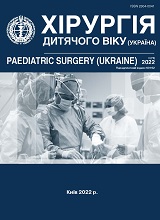Diagnostic value of clinical investigation of children with adhesive intestinal obstruction
DOI:
https://doi.org/10.15574/PS.2022.76.52Keywords:
children, diagnosis, clinical investigations, adhesive intestinal obstructionAbstract
Early diagnosis and objective determination of the presence and degree of intestinal obstruction is important for practicing surgeons. The abdominal X-ray examination, the contrast passage examination, and in some cases computer tomography are used for clinical confirmation of this pathological condition.
The purpose - to reveal the diagnostic value of clinical investigation methods in children with adhesive intestinal obstruction.
Materials and methods. We followed up 89 children with adhesive intestinal obstruction. All the children, in addition to a complete clinical physical examination during hospitalization, had the clinical investigation in order to verify the diagnosis: X-ray examination and ultrasound examination of the abdominal organs.
Results. According to our data, the main signs of intestinal obstruction at the X-ray examination of the abdominal cavity were the absence of gas in the large intestine (66; 74.2%), hydroaeric levels or Kloiber’s cups (58; 65.2%) and dilation of small intestine loops ≥3 cm (37; 41.6%); at the ultrasound of the abdominal organs - dilation of the small intestine loops ≥3 cm (70; 78.7%) and an ineffective peristalsis (33; 37.1%).
Conclusions. Rapid diagnosis of the surgical disaster in children with suspected adhesive intestinal obstruction and important information is provided by X-ray examination and ultrasound examination of abdominal organs. Ultrasound diagnosis of abdominal organs in patients with peritoneal adhesions is non-invasive and sufficiently informative for multiple monitoring of the disease and the effectiveness of treatment without negative impact on the patient.
The research was carried out in accordance with the principles of the Declaration of Helsinki. The research protocol was approved by the Local Ethics Committee of all the institutions mentioned in the work. Informed consent was obtained from parents (or guardians).
No conflict of interests was declared by the authors.
References
Almafreji I, Chinaka U, Hussain A, Lynch, M, Cottrell R. (2020). Role of Gastrografin in Patients With Small Bowel Obstruction. Cureus. 12 (8): e9695. https://doi.org/10.7759/cureus.9695
Bonnard A, Kohaut J, Sieurin A, Belarbi N, El Ghoneimi A. (2011). Gastrografin for uncomplicated adhesive small bowel obstruction in children. Pediatr Surg Int. 27 (12): 127-181. https://doi.org/10.1007/s00383-011-2963-8; PMid:21818521
Deng Y, Wang Y, Guo C. (2019, Mar). Prediction of surgical management for operated adhesive postoperative small bowel obstruction in a pediatric population. Medicine (Baltimore). 98 (11): e14919. https://doi.org/10.1097/MD.0000000000014919; PMid:30882714 PMCid:PMC6426593
Gerner-Rasmussen J, Donatsky AM, Bjerrum F. (2019). The role of non-invasive imaging techniques in detecting intra-abdominal adhesions: a systematic review. Langenbecks Arch Surg. 404 (6): 653-661. https://doi.org/10.1007/s00423-018-1732-8; PMid:30483880
Khan RA, Ara R, Wahab Sh, Ahmad I. (2019). Ultrasound in pediatric intestinal obstruction: Assessing its full potential. Paediatric Surgery. Ukraine. 4 (65): 19-24. https://doi.org/10.15574/PS.2019.65.19
Kvashnina AA, Melnychenko MG, Rybalchenko VF. (2022). Clinical effectiveness of sodium hyaluronate gel usage for prevention of postoperative adhesion in children. Modern Pediatrics. Ukraine. 2 (122): 21-26. https://doi.org/10.15574/SP.2022.122.21
Melnichenko M, Kvashnina A. (2020). Pathogenetic aspects of post-surgical adhesions prevention (review of literature). J Educ Health Sport. 10 (5): 380-393. https://doi.org/10.12775/JEHS.2020.10.05.040
MOZ Ukrainy. (2012). Pro zatverdzhennia protokoliv likuvannia ditei zi spetsialnosti «Dytiacha khirurhiia» iz zminamy vnesenymy nakazom Ministerstva okhorony zdorov'ia Ukrainy. Nakaz MOZ Ukrainy No 150.
Paily A, Kotecha J, Sreedharan L, Kumar B. (2019). Resolution of adhesive small bowel obstruction with a protocol based on Gastrografin administration. Med Life. 12 (1): 10-14. https://doi.org/10.25122/jml-2018-0082; PMid:31123519 PMCid:PMC6527405
Smereczyński A, Starzyńska T, Kołaczyk K, Bojko S et al. (2012). Intra-abdominal adhesions in ultrasound. Part I: The visceroperitoneal bordeline, anatomy and the method of examination. J Ultrason. 12 (51): 472-478. https://doi.org/10.15557/JoU.2012.0034; PMid:26674107 PMCid:PMC4603241
Smereczyński A, Starzyńska T, Kołaczyk K, Bojko S et al. (2013). Intra-abdominal adhesions in ultrasound. Part II: The morphology of changes. J Ultrason. 13 (52): 93-103. https://doi.org/10.15557/JoU.2013.0008; PMid:26675524 PMCid:PMC4613568
Ten Broek R, Krielen P, Di Saverio S, Coccolini F et al. (2018, Jun 19). Bologna guidelines for diagnosis and management of adhesive small bowel obstruction (ASBO): 2017 update of the evidence-based guidelines from the world society of emergency surgery ASBO working group. World J Emerg Surg. 13: 24. https://doi.org/10.1186/s13017-018-0185-2; PMid:29946347 PMCid:PMC6006983
Downloads
Published
Issue
Section
License
Copyright (c) 2022 Paediatric Surgery (Ukraine)

This work is licensed under a Creative Commons Attribution-NonCommercial 4.0 International License.
The policy of the Journal “PAEDIATRIC SURGERY. UKRAINE” is compatible with the vast majority of funders' of open access and self-archiving policies. The journal provides immediate open access route being convinced that everyone – not only scientists - can benefit from research results, and publishes articles exclusively under open access distribution, with a Creative Commons Attribution-Noncommercial 4.0 international license(СС BY-NC).
Authors transfer the copyright to the Journal “PAEDIATRIC SURGERY.UKRAINE” when the manuscript is accepted for publication. Authors declare that this manuscript has not been published nor is under simultaneous consideration for publication elsewhere. After publication, the articles become freely available on-line to the public.
Readers have the right to use, distribute, and reproduce articles in any medium, provided the articles and the journal are properly cited.
The use of published materials for commercial purposes is strongly prohibited.

